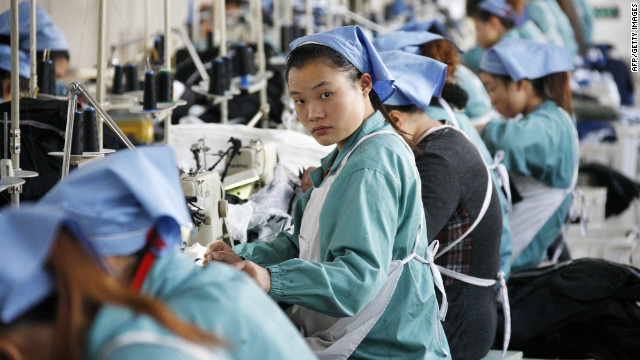|
One year after China launched the stimulus package and regained economic growth momentum, the consumption, output and investment of China's apparel industry all saw a increase in the first ten months while apparel export is still facing unprecedented challenges. Consumption: Jacket and cashmere staying warm From Jan. to Oct., apparel sales of China's top department stores climbed 25.73 percent to $8.688 billion, China General Chamber of Commerce said. In October, sales for easy wear remain robust during Chinese National Holidays season. Jacket sales were particularly strong, with jumpers up 25.84 per cent on last year. Many customers are opting for vogue jackets and moving away from the higher end of the pricing spectrum. "The challenging economy actually means that suppliers should focus more on fashion, not less. If you're bringing anything new into the industry, it's got to be fashion-sensitive and price-sensitive," Kevin Schardt, vice president of Hartwell Industries said.
Soft, warm and chic cashmere cardigans are a great layering piece when the weather gets cool. Sales of cashmere cardigans climbed 9.82 percent in Oct., because most customes believe cashmere cardigans are a great investment for their winter wardrobe. Recently, the National Bureau of Statistics of China said that apparel sales for Nov. had grown by 25.8%. Business sentiment about the retailing sector is also now positive. The retail sector looks set for a robust festive trading season, based on figures released so far. Production: remaining stable China's apparel industry saw a slight increase in the output in Oct., according to data collected from statistics-worthy Chinese apparel enterprises surveyed by China National Textile and Apparel Council.
Looking further, from January to October, the total new products output value of China's apparel industry reached CNY 39.72 billion, up 15.2% y/y; sales value CNY 675.21 billion, up 14.29%; export delivery value up 2.14%.
Investment: on rise 2009 is a critical period for the development of China Apparel industry. It is also the transitional period for China stepping from the "11th Five-Year Plan" to the "12th Five-Year Plan". In the context of global financial turmoil and severe overseas economic situation, a number of small technical reconstruction projects play an important role in driving the demand of apparel industry market. By the end of Oct., the accumulated fixed-assets investment in apparel textile industry was up 10.34% to CNY73.464 billion y/y. The industry registered new projects was up 26.05% y/y, according to the Statistics Center of CNTAC. Enterprises should take notice that, during next year's economic work, the government would improve policies to spur consumption and ensure investment grow at a reasonable pace, the Political Bureau of the Communist Party of China (CPC) Central Committee agreed on Nov. 27. It looks a little different from the former agreement on Sep. meeting. Export: still negative growth From Jan. to Oct., China's apparel exports declined by 10.55% compared with a year ago to $87.896 billion; China's apparel imports plummeted 22.39% compared with a year ago to $1.945 billion, according to China Customs. Apparel export faces unprecedented challenges. From Jan. to Oct., China's textile and garment reached 39.2 percent share of market in America, up 5% y/y. The result, some analysts argue, is that the widely-held theory that China is becoming a less competitive place to buy clothes from is just a myth. Prudent apparel buyers will always have an alternative source to China, and there's strong competition in many other countries. But China's going to provide the bulk of most buyers' clothing purchases for a good few years still. On the other hand, we should not be too optimistic. The export destination of China's apparel products are considered to be highly concentrated. This is reflected by the statistical data of the past couple of years when, the top export destinations are United States, Japan, Germany and UK. Unfortunately, these countries which stand as the major market for Chinese apparel exports, have become gloomy under the expanding impact of crisis. The quantities of export that we saw two years ago are not there. In this regard, China apparel industry should reduce its reliance on the single export market. On Nov. 27, the Political Bureau vowed to enhance the focus and flexibility of economic policy in the following year according to new situations. It would further implement and enrich the economic stimulus package to make the economy grow in a more stable, balanced and sustainable way. During next year's economic work, the government aims to boost domestic demand, especially the sustainable increase in consumption next year. The statement also said that more efforts would be made to promote reform, opening up and innovation, improve people's livelihood and maintain social stability and enhance the vigor and momentum of economic growth. Year 2009 is a toug year for China's textile and apparel industry. After the government launched the stimulus package and regained economic growth momentum, China textile and apparel industry has flown the China flag high. Globle recession is having an impact but the Chinese textile and apparel industry is resilient and it has to tackle the near-term issues and seek opportunities from challenges while keeping in mind the long-term view. Gracie Guo
|
|
Apparel Industry Posts Recovery in the First Ten Months
Updated: 2010-1-6 Source: CTEI

Recommended News
Photo Gallery
Most Popular



